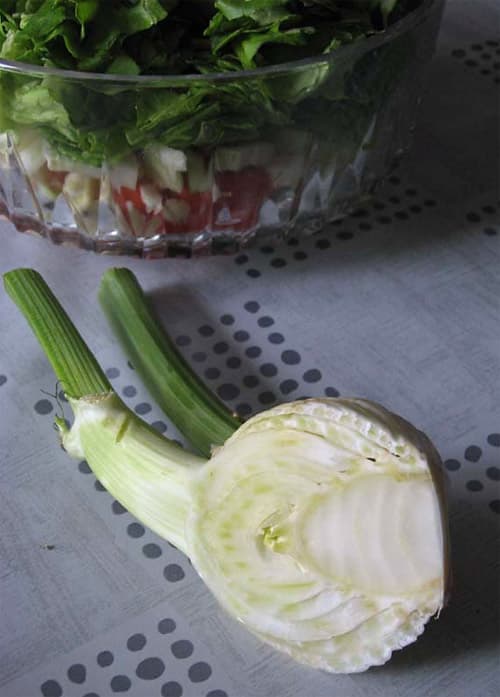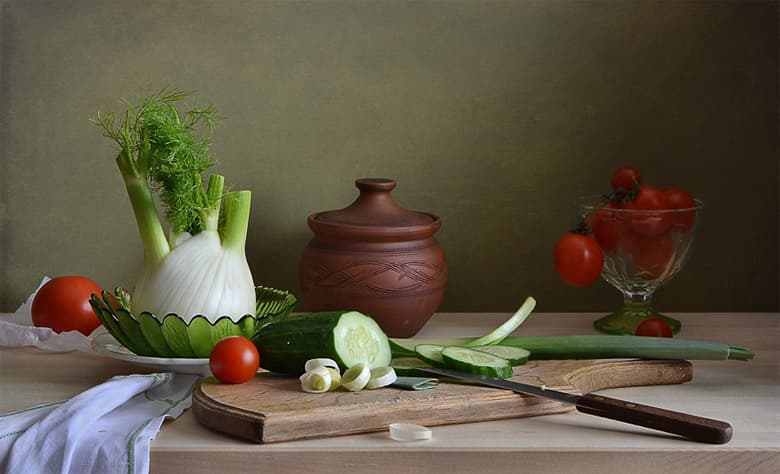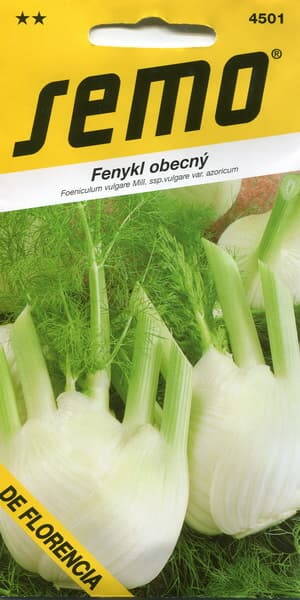Ex Tax: 1.25€
A perennial herbaceous plant of the umbrella family, 150-200 cm high. There are ordinary fennel and vegetable, or sweets.
The latter is grown in order to obtain a thickened part of the stem. Fennel is placed on fertile loamy soils, in open, sunny places.
Propagated by seeds. They are sown in mid-May at a depth of 2 cm, according to the scheme of 50 g 40 cm, at the rate of 0.8-1.0 g / m2.
Care consists of thinning, loosening row spacing, and top dressing. In vegetable fennel with a thickening of the stem, hilling is carried out.
It is cold-resistant, but without snow, it can freeze, so in the fall, it is covered with manure or humus. During the dry season, this crop requires watering.
Harvesting begins when the plants reach a diameter of 10 cm.
Stalks are eaten fresh, stewed and boiled, as an addition to soups, meat dishes and various salads.
It is used as an antimicrobial, anti-inflammatory, choleretic and diuretic, promoting digestion.
1 gram = 180-200 seeds.

Sow at the end of April in a sunny place with rich soil, leaving space between lines 30-40 cm. Seeds germinate slowly for 15-20 days.
The plant is used to cook aromatic meals and for medical purposes.

.jpg)
Various uses of fennel.
Fennel ordinary for the external resemblance of this spicy plant with dill is also called "pharmacy dill".
It is from fennel seeds that the so-called "dill water" of mild action with a pleasant taste and anise aroma is made, which is prescribed for babies to normalize digestion and eliminate intestinal colic.
However, not only fennel seeds but all these beautiful plants 1-2 m high a suppliers of useful substances and vitamins. Juicy young fennel greens with a specific sweetish taste and smell of anise can be added to the same dishes as dill.
Fresh and boiled petioles, fresh and stewed heads of cabbage and boiled fennel roots are also added to the first and second courses, of salads.
Fennel flowers are used to preserve vegetables. With the help of fruits, sweets and sauces are flavoured, as well as vegetable, meat and fish dishes.
Fennel fruits are also used in baking, the perfume industry and medicine. Fennel fruits have antispasmodic, expectorant, carminative, mild diuretic and laxative, carminative and other beneficial effects on the body, including stimulating the formation of milk in nursing mothers.
Fennel repels fleas, this property of the plant has been used since ancient times to protect pets from annoying insects. Finely chopped fresh fennel leaves are rubbed into pets' fur and laid out around and under the bedding.
Thanks to a powerful, highly branched bush with large pinnately dissected leaves, fennel can rightfully be classified as an ornamental plant suitable for decorating a garden.
Elegant varieties of fennel with coloured leaves have been bred: "Purpureum" - young leaves are bronze-purple, and later become bluish; "Giant Bronze" - young leaves are copper, and then turn brown-bronze.
Removing emerging inflorescences helps increase the number of leaves on fennel bushes and prevents unwanted self-seeding.
Large fennel bushes with an abundance of openwork leaves look great in the background of any flower bed. And you can also use fennel as an openwork hedge that divides the garden into zones.
Eng.: Bitter fennel, common fennel, garden fennel. Bot. syn.: Anethum foeniculum L., Foeniculum capillaceum , Foeniculum dulce Mill., Foeniculum foeniculum (L.), Foeniculum officinale All., Foeniculum panmoricum DC., Foeniculum piperitum (Ucria), Foeniculum vulgare Gaertn.
* Fennel salad with apples.
Grind one or two heads of fennel and one sour apple on a coarse grater. Mix everything, add lemon juice, salt and parsley - to taste.
* Stewed fennel.
Finely chop the heads of cabbage, stew with butter and onions, season with flour and pour in a little broth.
Before serving, add sour cream and finely chopped fennel leaves.
* Fennel fruits contain essential and fatty oils, proteins, flavonoids and sugars.
In the grass - essential oil, flavonoids, ascorbic acid, carotene, vitamins B, E, K.
Medicinal raw materials are the fruits and leaves of pharmaceutical dill.
The fruits have antispasmodic, antiemetic effects, enhance the secretion of the stomach, intestines, bronchi and mammary glands, stimulate appetite, improve digestion, relieve the stomach and intestines from gases, reduce and stop convulsions and gastrointestinal colic, have choleretic and diuretic, expectorant effect.
It is used as a carminative, for flatulence and as a gentle laxative, for urolithiasis and cholelithiasis, for coughs, bronchitis, pneumonia, pulmonary tuberculosis, as an expectorant for children suffering from bronchitis and whooping cough, being part of the liquorice elixir or complex powder in combination with liquorice root.
• Take 1 teaspoon of fruits before meals with 1/4 cup of warm water.
• Pour 2-3 g of crushed fruits into a glass of boiling water, strain after 15-20 minutes and add honey or sugar for taste.
Drink hot (in case of indigestion, the infusion is not sweetened).















